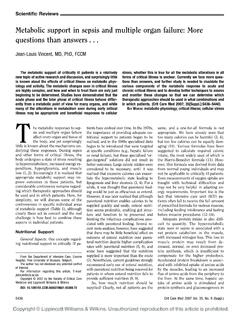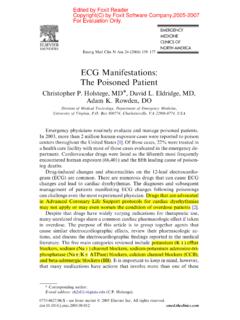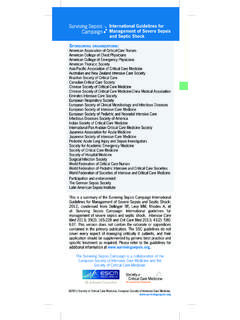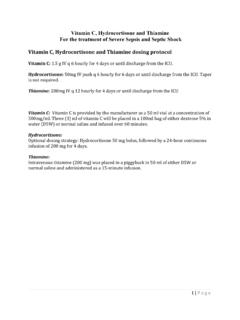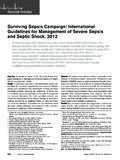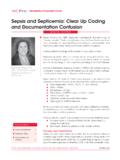Transcription of Diagnosis of Adrenal Insufficiency in Severe Sepsis …
1 Diagnosis of Adrenal Insufficiency in Severe Sepsis andSeptic ShockDjillali Annane, Virginie Maxime, Fidaa Ibrahim, Jean Claude Alvarez, Emuri Abe, and Philippe BoudouService de Re animation and Service de Biochimie-Pharmacologie, Ho pital Raymond Poincare , Faculte de Me decine Paris Ile de France Ouest,Garches; and Service de Biochimie Hormonale, Ho pital Saint Louis, Faculte de Me decine Saint Louis Lariboisie`re, Paris, FranceRationale: Diagnosis of Adrenal Insufficiency in critically ill patientshas relied on random or cosyntropin-stimulated cortisol levels, andhas not been corroborated by a more accurate diagnostic :We used the overnight metyrapone stimulation test toinvestigate the diagnostic value of the standard cosyntropin stimu-lation test, and the prevalence of Sepsis -associated :This was an inception cohort and Results:In two consecutive septic cohorts (n!)
2 61 and n!40), in 44 patients without Sepsis and in 32 healthyvolunteers, we measured (1) serum cortisol before and after cosyn-tropinstimulation,albumin,andcorti costeroid-bindingglobulinlevels,and (2) serum corticotropin, cortisol, and 11!-deoxycortisol levelsbefore and after anovernight metyrapone stimulation. Adrenalinsuffi-ciency was defined by postmetyrapone serum 11!-deoxycortisollevels below 7"g/dl. More patients with Sepsis (31/61 [59% oforiginal cohort with Sepsis ] and 24/40 [60% of validation cohortwith Sepsis ]) met criteria for Adrenal Insufficiency than patientswithout Sepsis (3/44; 7%) (p" for both comparisons). Base-line cortisol ("10"g/dl),#cortisol ("9"g/dl), and free cortisol("2"g/dl) had a positive likelihood ratio equal to infinity, (95% confidence interval, ), and (95% confidenceinterval, ), respectively. The best predictor of Adrenal in-sufficiency (as defined by metyrapone testing) was baseline cortisolof 10"g/dl or less or#cortisol of less than 9"g/dl.
3 The bestpredictors of normal Adrenal response were cosyntropin-stimulatedcortisol of 44"g/dl or greater and#cortisol of "g/dl :In Sepsis , Adrenal Insufficiency is likely when baselinecortisol levels are less than 10"g/dl or delta cortisol is less than9"g/dl, and unlikely when cosyntropin-stimulated cortisol level is44"g/dl or greater or#cortisol is "g/dl or :corticol injection; free cortisol; corticotropinAlmost one century after the original description of apoplexyof the Adrenal glands in septic shock (1), consensus is lackingon diagnostic criteria to define Adrenal Insufficiency in criticalillness (2). In unstressed subjects, Adrenal Insufficiency is defined(Received in original form September 3, 2005; accepted in final form September 8, 2006)Supported by a grant from De le gation Re gionale a`la Recherche Clinique, Ile deFrance Assistance Publique Ho pitaux de Paris (Ger-Inf-05R2 from Groupe d Etudeet Recherche sur le Me dicament [GERMED]).
4 The study sponsor had no responsibility for the study design, data analysis andinterpretation, or decision to submit this manuscript for and requests for reprints should be addressed to Djillali Annane, , , Service de Re animation, Ho pital Raymond Poincare (AP-HP), Faculte de Me decine Paris Ile de France Ouest (UVSQ), 104 Boulevard Raymond Poincare ,92380 Garches, France. E-mail: article has online supplement, which is accessible from this issue s table ofcontents at J Respir Crit Care Med Vol 174. pp 1319 1326, 2006 Originally Published in Press as DOI: on September 14, 2006 Internet address: A GLANCE COMMENTARYS cientific Knowledge on the SubjectAdrenal Insufficiency may be a frequent complication ofcritical illnesses such as Severe Sepsis , and may be associatedwith a worse outcome. Its Diagnosis remains This Study Adds to the FieldChanges in serum total or free cortisol after corticotropinbolus can be used to detect Adrenal Insufficiency in a cosyntropin-stimulated cortisol level less than 18 20#g/dl(3, 4).
5 In critical illness, the diagnostic criteria for Adrenal insuffi-ciency have included a random cortisol level lower than 15 (2)or 25#g/dl (5), or a cortisol increment after cosyntropin stimula-tion of 9#g/dl or less (2, 6). In patients with Severe hypoproteine-mia, Adrenal Insufficiency may be defined by serum free cortisollevel of less than #g/dl at baseline or less than #g/dl aftercosyntropin stimulation (7). We have recently provided dataunderscoring the clinical significance of Adrenal insufficiencyin patients with septic shock (8 11). After 250#g cosyntropinstimulation, patients with a cortisol increment of 9#g/dl or less(nonresponders to cosyntropin) had vasopressor hyporespon-siveness (8), higher risk of death (9), and improved response toprolonged corticosteroid supplementation (10, 11). However,that nonresponders to cosyntropin had Adrenal Insufficiency re-mains fact, the use of the cosyntropin stimulation test to assessadrenal function may present some variability (12), and maylead to misdiagnosing secondary Adrenal Insufficiency (13).
6 Moresensitive and cumbersome reference tests, such as insulin toler-ance and metyrapone stimulation, have not been evaluated inintensive care unit (ICU) patients (2). Today, the use of insulintolerance is impractical, because intensive insulin therapy hasbecome a standard of care for ICU patients (14, 15), and septicshock is commonly associated with peripheral insulin this reason, we used the overnight single-dose metyraponestimulation test to investigate the diagnostic value of the stan-dard 250-#g cosyntropin stimulation, and the prevalence ofsepsis-associated Adrenal PopulationThe CCPPRB de St. Germain en Laye approved the study, and healthyvolunteers and patients or their relatives provided written informedconsent before with SepsisAll consecutive ICU patients were prospectively included if they hadsevere Sepsis or septic shock (16). Patients who were enrolled from1320 AMERICAN JOURNAL OF RESPIRATORY AND CRITICAL CARE MEDICINE VOL 174 2006 February 2002 to May 2004 constituted the original cohort with Sepsis ,and those recruited from December 2005 to April 2006 constituted thevalidation cohort with Patients with No SepsisFrom December 2005 to April 2006, ICU patients without Sepsis whowere expected to have intact Adrenal function and a short ICU stayserved as control criteria for patients with Sepsis and those without sepsiswere as follows: age of less than 18 yr; pregnancy or breast-feeding;history of infection with human immunodeficiency virus; any knownpreexisting endocrine or liver disease (including any stage of cirrhosis,acute or chronic viral hepatitis, alcoholic liver disease, or hepatictumors).
7 Any treatment with etomidate, glucocorticoids, estrogen, orany drug interfering with the hypothalamic pituitary Adrenal axis inthe preceding 6 mo (4, 17).At study entry, the following parameters were recorded: time fromICU admission; age and sex; past medical history and estimated prognosisof any underlying disease, stratified according to the criteria of McCabeand Jackson (0, nonfatal; 1, ultimately fatal [ ,"5 yr]; or 3, rapidlyfatal [ ,"1 yr]) (18); severity of illness, as assessed by the SimplifiedAcute Physiology Score (SAPS) II (scores can range from 0 to 163,with higher scores indicating higher risk of death) (19); the Sepsis -Related Organ Failure Assessment (SOFA) score (score can range from0 to 24, with scores for each organ system [respiratory, hematological,hepatic, cardiovascular, neurological, and renal] ranging from 0 [nor-mal] to 4 [most abnormal]) (20); and vital signs.
8 Laboratory measure-ments included arterial blood gas, with the ratio of the partial pressureof arterial oxygen to the fraction of inspired oxygen, lactate levels,blood and urinary electrolytes concentration, total white blood cells,eosinophil and platelet counts, and serum levels of albumin and ICU admission, patients had blood samples drawn before and60 min after a 250-#g cosyntropin administration. Later that day ($8 h),patients received an overnight single-dose metyrapone stimulation testFigure chart of patients assessedfor eligibility in the study.(30 mg/kg of the Adrenal 11%-hydroxylase inhibitor, metyrapone, admin-istered through the gastric tube at midnight during enteral nutrition);(3) blood samples were drawn before the test and at followingmorning. Then, 50 mg hydrocortisone was given intravenously every6 h and 50#g of fludrocortisone through the gastric tube once daily,or for 7 d in nonresponders to cosyntropin (10).
9 A total of 32 healthy,sex-matched subjects (age, 16 72 yr) underwent similar Standard for the Diagnosis of Adrenal Insufficiencyand Nonresponders to CosyntropinThe metyrapone stimulation test is based upon the fact that low serumcortisol levels normally stimulate secretion of the adrenocorticotropichormone (ACTH), corticotropin. Metyrapone blocks the conversionof 11%-deoxycortisol to cortisol, the last step in the biosynthetic pathwayfrom cholesterol to cortisol. As a result, cortisol synthesis and secretionfall while 11%-deoxycortisol accumulates in serum. Adrenal insuffi-ciency was defined by an increment from baseline in 11%-deoxycortisolconcentration of less than 7#g/dl at 8 while cortisol level hadfallen below 8#g/dl (3). Those who also had a corticotropin levelof less than 150 pg/ml were considered as having secondary adrenalinsufficiency.
10 We assumed that metyrapone was well absorbed, and thatresults could be reliably interpreted when cortisol level at 8 than 8#g/dl and peak metyrapone level was 100 ng/ml or , patients with a cortisol increment after cosyntropin of 9#g/dlor less were considered to be nonresponders to cosyntropin; the re-mainders were considered to be responders (9)Hormonal AssaysCortisol and corticosteroid-binding globulin were assayed at baselineand 60 min after cosyntropin stimulation. Corticotropin, cortisol, 11%-deoxycortisol, and metyrapone were assayed at baseline and at 8 metyrapone administration. Plasma corticotropin and cortisol levelswere measured using chemiluminescence immunoassays (NicholsInstitute Diagnostics, San Clemente, CA). The intra-assay and interassayAnnane, Maxime, Ibrahim,et al.: Adrenal Failure in Sepsis1321coefficients of variation for corticotropin ranged from to andfrom to , respectively, and those for cortisol ranged from and from to , respectively.
